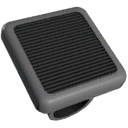Pipe Radiator
From Unofficial Stationeers Wiki
 | |
| Properties | |
|---|---|
| Stacks | Yes (10) |
| Paintable | Yes |
| Recipe | |
| Created With | Hydraulic Pipe Bender |
| Cost | 3g Gold, 2g Steel |
 | |
| Paintable | Yes |
|---|---|
| Operation | |
| Construction | |
| Placed with | Kit (Radiator) |
| Placed on | Small Grid |
| Paintable | Yes |
| Stage 1 | |
| Deconstruction | |
| Deconstructed with | Wrench |
| Item received | Pipe Radiator |
Description
Used to cool or warm the gasses within pipes.
- In an atmosphere the radiators will convert energy based on their temperature and the atmosphere.
- If the pipe has a higher temperature then they will transfer heat into the room.
- If the pipe has a lower temperature then they will receive heat from the room.
- Without an atmosphere they will radiate heat into space. Note that they will receive a little energy if the sun shines on them due to the solar constant (The ability for pipe radiators to absorb thermal energy in any environment in game is contested).
In layman's terms you can think of the radiator as a "valve for heat". It will allow heat (but no gases!) to be exchanged between the pipe it's attached to and the surrounding environment. This "valve" will work bidirectional (heat can flow in both directions). And heat will always flow from the hotter to the colder side.
Pipes without radiators are actually capable to exchange heat with their surroundings the same way on their own. But a radiator will greatly accelerate how fast this exchange will happen. And the effect of multiple radiators on the same pipe system will be cumulative. So you can speed up the transfer even more by placing more than one radiator on the same pipe system. The "shape" of the pipe system is not relevant, though. So a straight pipe with a certain amount of radiators will have the same heat exchange than a pipe of equal length (same amount of pipe segments) and equal amount of radiators, that snakes around or forms any other imaginable shape.
Another factor that will influence how well (and how much) heat will be transferred between the pipe/radiator and it's surroundings is the gas mixture inside both the pipe and it's surroundings. Gases differ in both the "speed" in which they can exchange heat and the "amount" of heat they can "absorb". Pollutants (X) for example are able to exchange heat very quickly, but the "amount" of heat they can absorb is limited. Water (H2O) on the other hand will exchange heat slower that pollutants will, but the "amount" of heat water can absorb is significantly larger.
